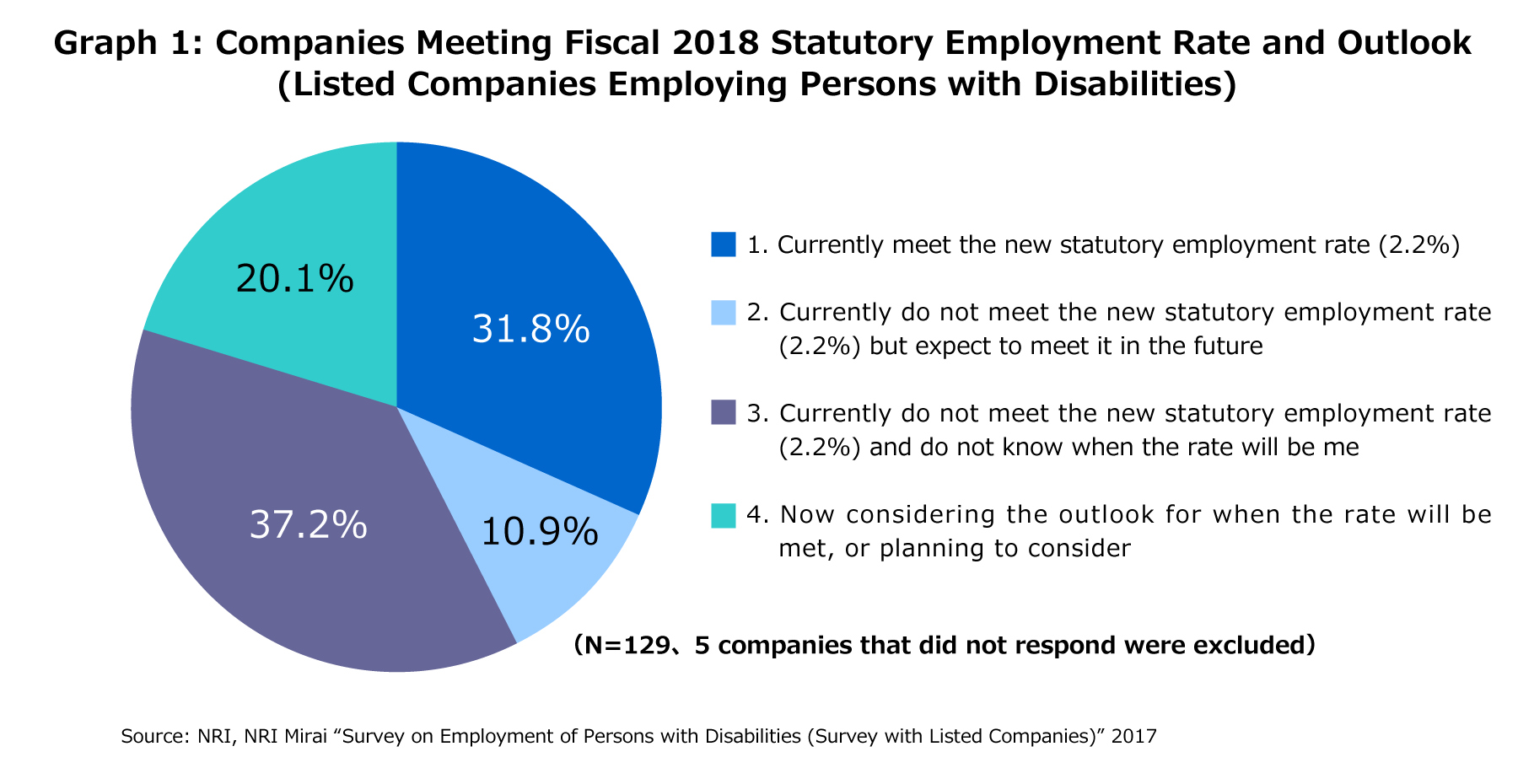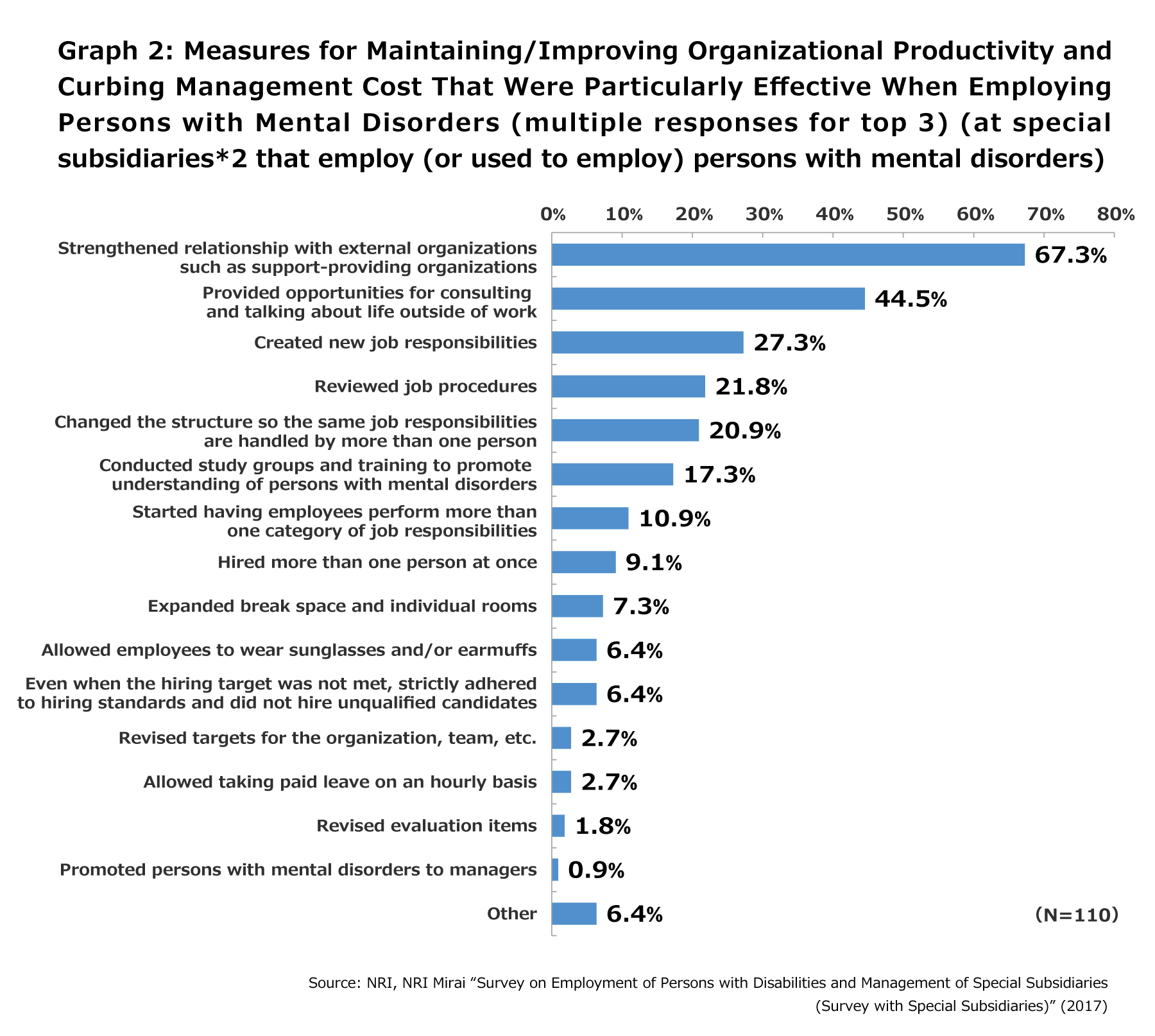
Higher Statutory Employment Rates to Result in Diversification and Sophistication of Employment of Persons with Disabilities
Today, the environment surrounding the employment of persons with disabilities is changing drastically. The Ministry of Health, Labor and Welfare decided in May 2017 to raise the statutory employment rate for persons with disabilities*1 at private companies from 2.0% to 2.2% in fiscal 2018, and to 2.3% by the end of fiscal 2020. In fiscal 2018, the base for computing the statutory employment rates will include persons with mental disorders as well. We at NRI and NRI Mirai expect the latest law amendment to bring about further changes to the employment of persons with disabilities, in the form of diversification and sophistication. Given such changes in the climate, let’s examine how companies will be expected to respond.
Increased Diversity in Staff and Job Responsibilities
A 2017 survey by NRI found that, at the time of the survey, only 31.8% of listed companies met the statutory employment rate of 2.2% that would take effect in fiscal 2018. That is to say, roughly seven out of 10 companies needed to hire more people with disabilities in order to meet the statutory employment rate.
At a time when many companies need to employ more persons with disabilities, the inclusion of persons with mental disorders in the base for computing the statutory employment rate, and the hike of the rate itself, are expected to spur more companies to work on expanding the employment of persons with mental disorders in addition to those with physical and intellectual disabilities, whom they had actively hired until now. This is expected to result in greater diversity of human resources. Moreover, while persons with disabilities who work at companies mostly handled administrative support, cleaning and management until now, the anticipated increase and diversification of workers with disabilities will likely result in a need to assign a broader range of job responsibilities to these persons.

Sophisticated Management Needed for Employment of Persons with Disabilities
With greater organizational diversity and a broader range of job responsibilities, companies will require more “sophisticated” management than ever before. Typical examples of enhancing management skills include identifying problems and making them visible and adopting the PDCA cycle, but we at NRI are focusing on the acquisition and development of personnel.
With greater organizational diversity and a broader range of job responsibilities, companies will face the question of how best to assign diverse job responsibilities to a diverse workforce. Acquiring and developing personnel who will take on responsibilities that require particularly advanced technology or skills will support the medium- to long-term growth of a company and help persons with disabilities grow as individuals and remain motivated.
Solutions for Diversification and Sophistication from the Perspective of Recruiting and HR Development
To answer the question of how best to acquire and develop personnel, we at NRI believe partnership with an external support-providing organization is effective.
In employing persons with disabilities, in particular those with mental disorders, a company needs to pay close attention to how they manage their physical health during work hours and outside the workplace, or how they manage the non-work aspects of their lives. Partnering with an external support-providing organization will make it possible to manage these matters with additional information from outside the company. Moreover, besides in-house training, one way of developing persons with disabilities is stronger partnership with an external support-providing organization.
According to an NRI study conducted in Germany, an employment support organization called IFD (Integrationsfachdienst)provides staffing services for persons with disabilities, and one IFD location takes as long as 10 months to place one person. Moreover, even after persons with disabilities start working, IFD provides counseling and advice to both companies and persons with disabilities. By taking a long time for matching, IFD is able to identify persons who are most suitable for various companies and job responsibilities, and as a result Germany maintains a higher employment rate than Japan.
Data shows that partnership with an external support-providing organization is effective in Japan as well. A 2017 survey by NRI revealed that companies that employ persons with mental disorders have found a stronger relationship with external institutions such as support-providing organizations to be particularly effective as a measure for maintaining or improving organizational productivity and curbing management costs.

With the environment for employing persons with disabilities growing diverse and sophisticated, NRI has focused on personnel acquisition and development and proposed a solution of partnering with an external support-providing organization. But there are many other challenges that companies must overcome going forward. The time has come for companies to reform their management and follow a new path, keeping in mind the two ways in which the employment of persons with disabilities in Japan is changing: diversification and sophistication.
-
*1
Statutory employment rate:
Under the Act on Employment Promotion etc. of Persons with Disabilities, private companies, government organizations, and regional public entities are required to employ persons with disabilities as a certain percentage of their total full-time workforce, and the rates of employing persons with disabilities for each employer are called the statutory employment rates. As of December 2017, the rates are 2.0% for private companies; 2.2% for prefectural boards of education, etc.; and 2.3% for the government, local public entities and special public corporations. Companies meeting the statutory employment rate have been increasing since 2013, and 48.8% of private companies met the rate in June 2016 (Annual Report on Government Measures for Persons with Disabilities 2017, Cabinet Office) -
*2
Special subsidiaries:
Subsidiaries are approved as “special” subsidiaries if they (1) take special consideration for the employment of persons with disabilities and meet certain statutory requirements, and (2) are recognized as an office of their parent companies when the government calculates the rates of employment of persons with disabilities. Given that special subsidiaries are a separate judicial person, it is possible to create an environment and design a system that meet the needs of and accommodate the skills of persons with disabilities. The number of special subsidiaries is on the rise, totaling 448 as of June 1, 2016, up 129 from June 1, 2011 (“List of Special Subsidiaries” and “Overview of the Special Subsidiaries System”, the Ministry of Health, Labor and Welfare)
Profile
-
Keisuke Mizunoura
-
Kazuya Ishihara
-
Kurumi Terashita
* Organization names and job titles may differ from the current version.